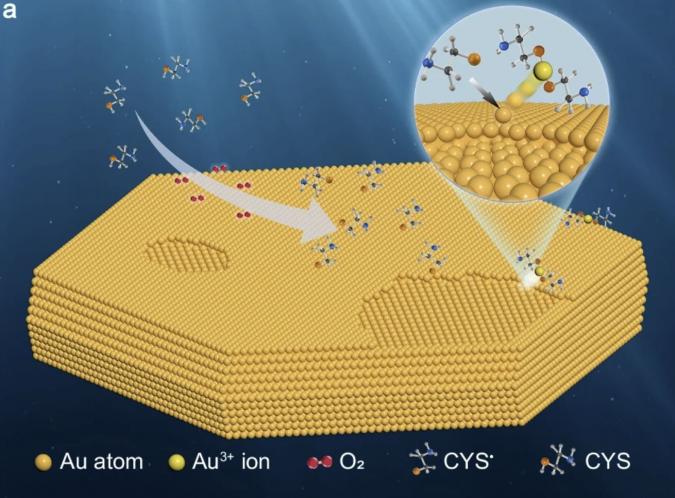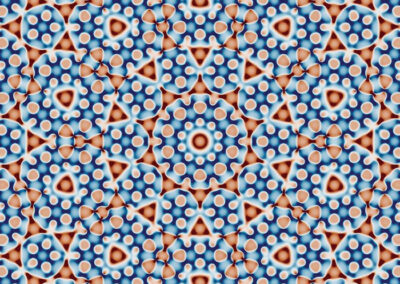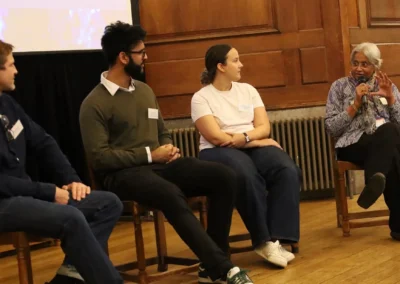Two-dimensional single-crystal metals have long been coveted for their potential to drive next-generation technologies, as they offer a unique interplay between highly confined optical modes and quantum phenomena.
Research carried out by LCN researchers at King’s College London with colleagues at Zhejiang University has unveiled a significant breakthrough by introducing large area single crystal two-dimensional gold flakes (2DGFs) with thicknesses down to a single nanometre level. The researchers report in Nature Communications that this remarkable achievement was made possible through the application of an atomic-level precision chemical etching approach, resulting in unprecedented control over material dimensions.
The reduction of thickness to such minute scales triggers the quantisation of electronic states within the 2DGFs, thereby enhancing their optical nonlinearity through quantum confinement effects. Remarkably, these ultrathin flakes exhibit over two orders of magnitude enhancement in harmonic generation compared to their thick polycrystalline counterparts, marking a significant leap in optical performance.
Moreover, the nanometre-scale thickness and exceptional single-crystal quality of the 2DGFs pave the way for the realisation of plasmonic nanostructures with unparalleled optical confinement. The researchers demonstrated this potential by patterning the 2DGFs into nanoribbon arrays, which exhibited strongly confined near-infrared plasmonic resonances characterised by high-quality factors.
With their unique combination of properties, these materials stand at the forefront of advancing nanotechnology and are poised to drive innovations in the following fields in the foreseeable future:
Nanophotonics: The ultrathin nature and exceptional optical properties of 2DGFs make them ideal candidates for applications in nanophotonics. They can be utilised in the development of highly efficient photonic devices such as nanoscale lasers, photodetectors, and modulators. Their ability to support strongly confined plasmonic resonances enables the manipulation of light at the nanoscale, facilitating advancements in integrated photonics and on-chip optical communication systems.
Plasmonics: Plasmonic nanostructures based on 2DGFs offer unprecedented control over light-matter interactions at the nanoscale. They can be employed in the development of novel plasmonic devices for enhanced sensing, spectroscopy, and imaging. The strong confinement of plasmonic modes in 2DGFs enables the realisation of ultra-compact and highly sensitive biosensors, as well as advanced imaging techniques with subwavelength resolution.
Optoelectronics: 2DGFs hold great promise for revolutionising optoelectronic devices due to their unique combination of optical and electronic properties. They can be integrated into ultra-thin and flexible optoelectronic devices such as photovoltaic cells, light-emitting diodes (LEDs), and photodetectors. The quantum confinement effects in 2DGFs enhance their light-matter interactions, leading to improved device performance and efficiency.
Quantum Technologies: The quantum confinement effects observed in 2DGFs open up exciting opportunities for applications in quantum technologies. These materials can be utilised in the development of quantum sensors, quantum information processing devices, and quantum communication systems. The precise control over electronic states in 2DGFs enables the generation and manipulation of quantum states of light and matter, paving the way for advancements in quantum computing and cryptography.
Materials Science: 2DGFs represent a new class of two-dimensional materials with unique structural and electronic properties. They serve as model systems for studying fundamental physical phenomena such as quantum confinement, surface plasmon resonance, and electron-phonon interactions. Additionally, their synthesis and characterisation provide valuable insights into the growth mechanisms and properties of other 2D materials, contributing to the advancement of materials science and engineering.
Links:



